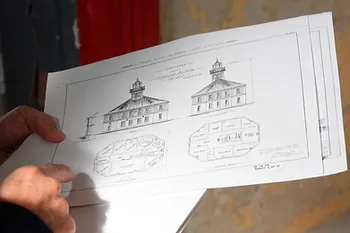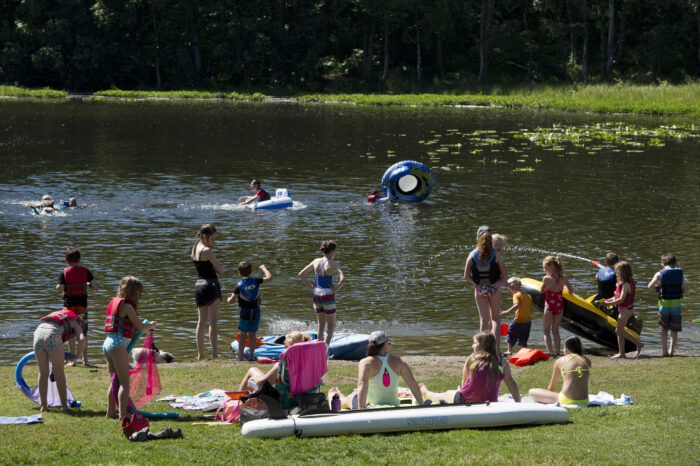The Eldred Rock Lighthouse
Alaska’s Oldest Lighthouse
In the midst of a raging storm with hurricane-force winds, reaching an estimated speed of ninety miles per hour, the Clara Nevada set sail on a multi-day journey from Skagway to Seattle on February 5th, 1898. This perilous voyage occurred during the height of the Alaskan gold rush, carrying more than one hundred passengers, including frustrated fortune seekers, over 800 pounds of precious gold, and even an illegal shipment of dynamite. Tragically, just over thirty miles into her southward journey, the ship met its doom, running aground at Eldred Rock and erupting into a fiery inferno.

Whether the loss of the Clara Nevada resulted from an accident or an act of sabotage remains a mystery, but the incident convinced Congress of the need for a lighthouse on Eldred Rock. The Lighthouse Board approved plans for this new beacon in May 1905, hoping that it would be completed before the harsh winter weather arrived in November. However, nature did not cooperate, and the Eldred Rock Lighthouse was not activated until June 1, 1906, making it the final addition to the twelve lighthouses constructed in Alaska between 1902 and 1906.
Similar to many early northern lights, the Eldred Rock Lighthouse featured an octagonal tower rising from the center of an octagonal building with a sloping roof. Notably, this building was larger than its counterparts, boasting two stories instead of one. The bottom story was constructed of concrete, while the upper story and tower were made of wood. This robust foundation has allowed Eldred Rock Lighthouse to stand for over a century, outlasting its Alaskan contemporaries that were replaced after just a few decades of service. The lighthouse provided ample living quarters for its keepers, accompanied by a noisy neighbor – a first-class compressed-air siren. The bottom floor housed the fog signal, a furnace, storage tanks for fuel and water, workrooms, and a bathroom. Meanwhile, the three keepers enjoyed eight rooms on the upper story. A wooden boathouse, situated 300 feet north of the lighthouse, was part of the 2.4-acre lighthouse reservation, and a carpenter shop was later added between these two structures. A tramway connected the boathouse to the lighthouse and extended to low water in both northeast and southwest directions.
 A fourth-order Fresnel lens graced the lantern room near the top of the fifty-six-foot lighthouse, positioned at a focal plane of ninety-one feet above the surrounding water. This unique lens, crafted in Paris by Barbier, Benard & Turenne, featured two bull’s-eye panels, one approximately four feet in diameter and the other a smaller fourteen-inch panel. A sheet of ruby glass between the light source and the larger prism caused the revolving lens to emit alternating red and white flashes of nearly equal intensity. Every five hours, the keepers had to wind up a 135-pound weight, causing the lens to rotate once every twenty seconds.
A fourth-order Fresnel lens graced the lantern room near the top of the fifty-six-foot lighthouse, positioned at a focal plane of ninety-one feet above the surrounding water. This unique lens, crafted in Paris by Barbier, Benard & Turenne, featured two bull’s-eye panels, one approximately four feet in diameter and the other a smaller fourteen-inch panel. A sheet of ruby glass between the light source and the larger prism caused the revolving lens to emit alternating red and white flashes of nearly equal intensity. Every five hours, the keepers had to wind up a 135-pound weight, causing the lens to rotate once every twenty seconds.
On May 14, 1906, a letter instructed Nils Peter Adamson, assistant keeper of Desdamona Sands Lighthouse on the Columbia River, to take charge of Eldred Rock Lighthouse. Adamson and his two assistants, Gust Hall and John Anderson, reached the station in time for the light and fog signal to begin operation. On the evening of March 12, 1908, a violent gale struck Eldred Rock. The next morning, assistant keeper John Currie made a shocking discovery as he ventured outside the lighthouse – the Clara Nevada had been brought back to the surface by the powerful storm, just days after the tenth anniversary of its sinking. However, the tempestuous weather quickly returned the ship to the depths of the canal.
In February 1910, two assistant keepers, John Currie and John Silander, set out from Eldred Rock in the station’s launch for Point Sherman. When they failed to return after three days, Keeper Adamson initiated a search. Sadly, the missing launch was found, stripped of gear, with no sign of the assistants. The tragic mystery haunted Keeper Adamson, who eventually resigned and moved to Astoria, Oregon. During World War II, five Coast Guard members stationed at Eldred Rock Lighthouse worked in three eight-hour shifts to maintain a continuous watch. The crew rotated duties monthly, with one member serving as the cook and another handling maintenance work to prevent boredom. Jack Goehring, one of the crew members, learned to cook during his time on the island, where complaining about the food meant taking up the cooking responsibilities.
Dave Hardman served as the station engineer in 1961, responsible for diesel-powered generators, foghorn air compressors, and the radiobeacon. Supplies and mail arrived every couple of weeks, with winter months bringing reduced visit frequencies due to fierce winds. In 1962, Gordon Huggins, Hardman’s successor, achieved a remarkable feat by planting trees on Eldred Rock, breaking the island’s history of failed attempts at tree growth. Huggins returned to the island for the filming of a PBS special, paying a visit to his surviving tree.
From September 1971 to the following October, Tom Schmidt served as the Officer-in-Charge at Eldred Rock. The crew enjoyed various recreational activities, including a pool table, ping pong table, slot car track, and nightly movie screenings. Dinner was a communal affair on weeknights, with good food helping to maintain morale. The station relied on three Caterpillar generators, with one in use each day on a rotating basis. Hourly hand-cranking was required to pump fuel to the generator’s day tanks. Water supply primarily relied on snow and rain, collected via boards on the roof, which would melt and drain into gutters, eventually feeding into a cistern on the lower level. In winter, each man was allowed just one shower per week to conserve water.
However, in 1973, personnel were removed from Eldred Rock Lighthouse, leading to the discontinuation of the fog signal and radiobeacon. The isolation of Haines increased as the cold, uninhabited lighthouse stood sentinel amidst the unpredictable Lynn Canal weather. After automation, the original Fresnel lens was acquired by the Alaska State Museum in 1976 and later loaned to the Sheldon Museum and Cultural Center, where it remains on display within a wooden case reminiscent of the lantern room atop Eldred Rock Lighthouse.
 Eldred Rock Lighthouse was designated on the National Register of Historic Places in 1975, along with Cape St. Elias Lighthouse and Cape Spencer Lighthouse, becoming the first Alaskan lighthouses to receive such recognition. The remaining eight Alaskan lighthouses were added to the register between 2002 and 2005. In efforts to acquire the lighthouse through the National Historic Lighthouse Preservation Act of 2000, the Sheldon Museum formed the Eldred Rock Lighthouse Committee. However, in 2004, the Forest Service, which controls part of Eldred Rock, refused to allow its property to be transferred into private hands. In response, the Eldred Rock Lighthouse Preservation Association was established in 2014, aiming to acquire, restore, and promote the lighthouse.
Eldred Rock Lighthouse was designated on the National Register of Historic Places in 1975, along with Cape St. Elias Lighthouse and Cape Spencer Lighthouse, becoming the first Alaskan lighthouses to receive such recognition. The remaining eight Alaskan lighthouses were added to the register between 2002 and 2005. In efforts to acquire the lighthouse through the National Historic Lighthouse Preservation Act of 2000, the Sheldon Museum formed the Eldred Rock Lighthouse Committee. However, in 2004, the Forest Service, which controls part of Eldred Rock, refused to allow its property to be transferred into private hands. In response, the Eldred Rock Lighthouse Preservation Association was established in 2014, aiming to acquire, restore, and promote the lighthouse.
In 2019, the Alaska Association for Historic Preservation granted funding for a historic structure report, guiding the property’s rehabilitation. In April 2020, the Coast Guard Civil Engineering Unit awarded a five-year lease of Eldred Rock Lighthouse to the preservation association, allowing access for restoration work.
Asbestos and lead paint have been safely removed and encapsulated by the preservation association, enabling work parties to stay inside the lighthouse. Eldred Rock Lighthouse has made the Alaska Association for Historic Preservation’s Ten Most Endangered Historic Properties List from 2017 to 2022, but ongoing efforts by the Eldred Rock Preservation Association are expected to change this.
To raise funds for the lighthouse’s eventual restoration, Haines resident Pam Randles collaborated with Dan Henry, a drama coach at the University of Alaska Anchorage, to produce a play titled “The Strange Fate of the Clara Nevada.” This visually striking play, featuring powerful storms, has been performed at the Sheldon Museum and in local communities. The wreck of the Clara Nevada, which led to the establishment of Eldred Rock Lighthouse, now plays a central role in the mission to save and restore this historic beacon, with the hope that some of the gold from the Clara Nevada could miraculously fund its complete restoration, creating a perfect ending to this storied history.
Photos courtesy of Lighthousefriends.com, Eldred Rock Lighthouse Preservation Association









